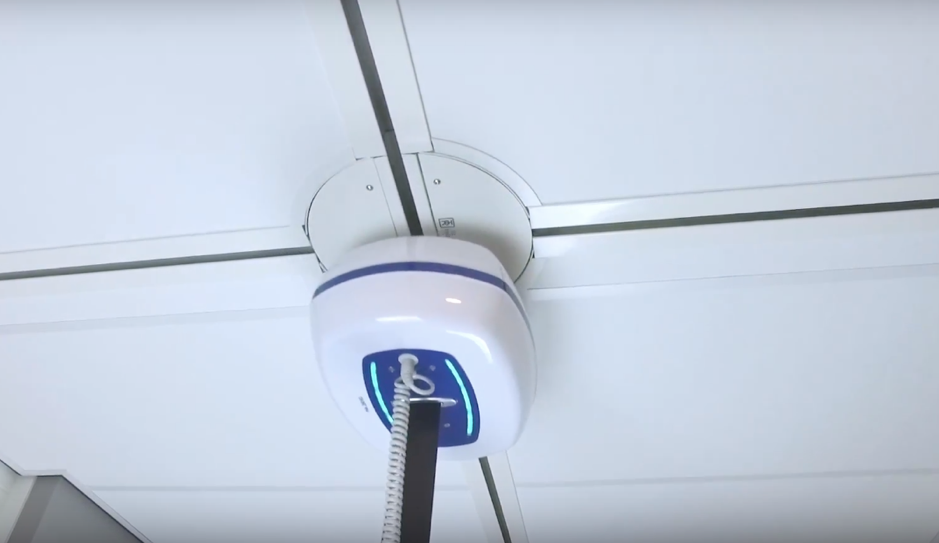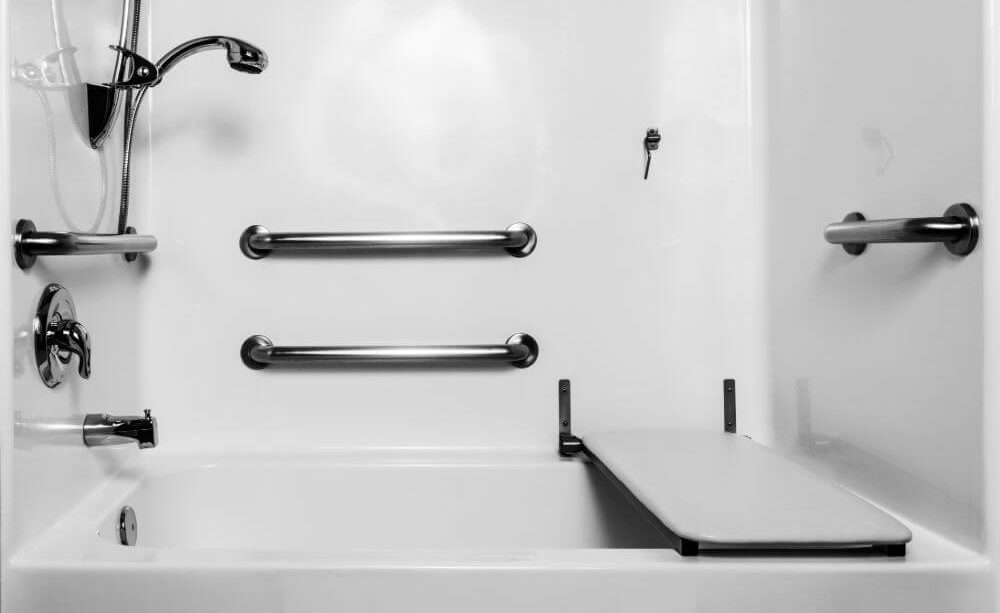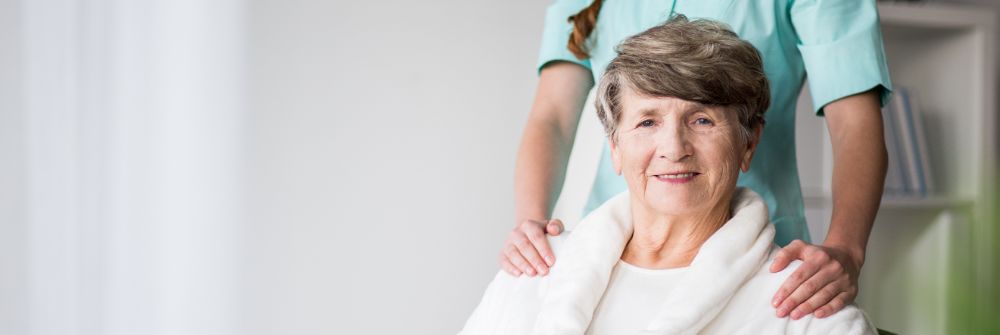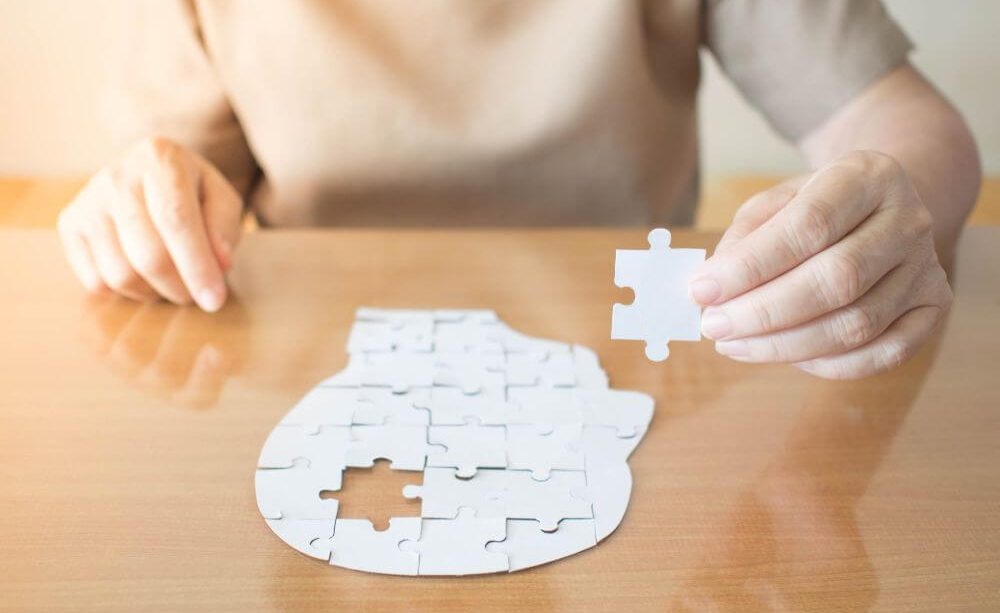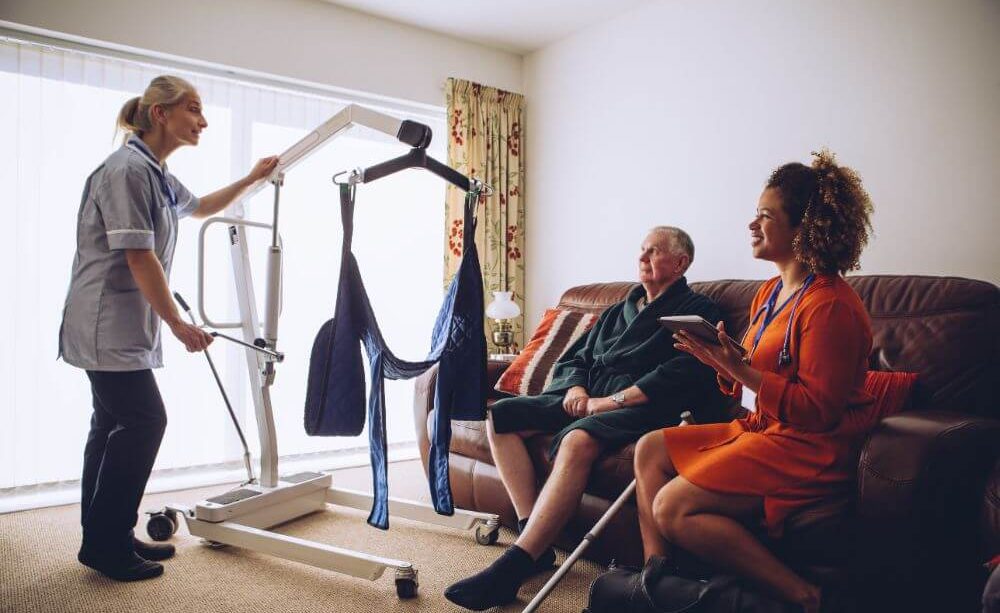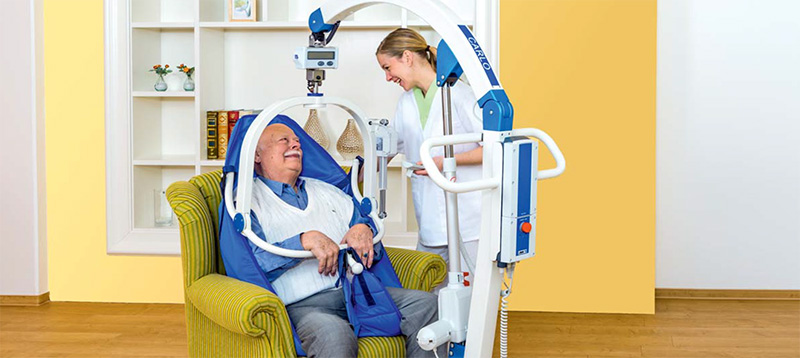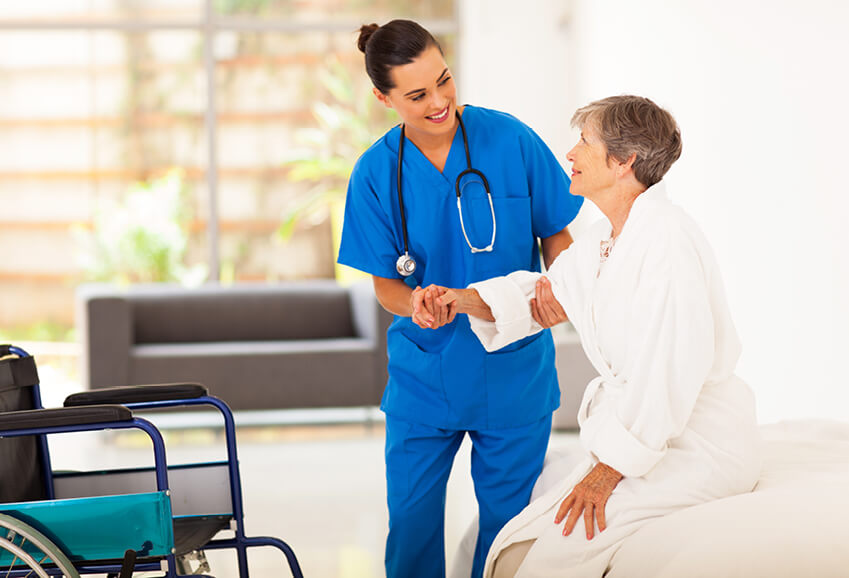Ceiling Hoist Options – Patient Lifting Solutions
CHS Healthcare is the exclusive Australian distributor PLS Patient Lifting Solutions. As a company dedicated to the design and manufacture of lifting solutions for every ceiling and situation, the partnership between PLS and CHS Healthcare allows us to offer our clients some of the top mobility assistance equipment on the market.
The selection and installation of a ceiling hoist requires a thorough decision-making process with several important considerations. Advances in technology continue to make lifting solutions cheaper, safer and easier to operate. Even so, a ceiling hoist is a specialised piece of equipment that is likely to have a significant cost. Considering the level of investment required, it’s critical to assess the most important criteria involved:
Environment
The location in which the ceiling hoist will be used is critical to making the selection. Whether this is in a hospital, nursing home or domestic setting, the setting will define constraints around which type you need and the path of the track.
Condition of Patient or User
It’s vital to take both the physical and cognitive capabilities of the patient into account. The degree of assistance required by the user is certain to play a role in deciding which hoist is needed. Cognition and body condition may prevent someone from being able to use the hoist on their own at all. Depending on the setting, the hoist will be used by many individuals. In this case, multiple users should be taken into account.
Ability of Carer
In circumstances requiring more assistance, the ability of the carer to manoeuvre the patient requires thought. Most caregivers are trained for patient/user movement and handling, though this may not be the case in a domestic environment. Selecting the right equipment must be done in compliance to both the abilities of the caregiver and user. Failure to do so has the potential to cause injury to either party.
PLS ceiling hoists are one of the leading options in the country – they certainly merit consideration for any individual or organisation in the market for a lifting solution. PLS hoists utilise a unique smart software and sensor motion technology that ensures smooth motion and eliminates the need for wall switches or rail contacts. For tracked hoists, this feature is an immense benefit. Less components also reduces the likelihood that something can go wrong. PLS systems are designed for superior useability for both patients and carers. Smart features like automatic standby and compatibility with electronic spreader bars make PLS ceiling hoists some of the most advanced and reliable on the market.
PLS ceiling hoists offer excellent answers to mobility issues. When choosing a ceiling hoist, it’s important to explore your options, as making the right decision is crucial.
If you want to learn more about PLS lifting solutions, visit their website or the CHS Healthcare PLS page.
Top Tips on Safe Assisted Showering and Bathing
Older adults are unfortunately more likely to experience injuries while falling in a bathroom. Declining mobility and cognition can turn simple tasks into hurdles. Eventually some people need assistance showering and bathing.
These tasks can present a significant hazard. Hard and wet surfaces in small bathroom spaces increase the severity of a simple fall.
Environment
By taking control of the environment, you can put safeguards in place for the resident and yourself
Ways to improve conditions include:
- Install handrails, providing support. Try to keep them dry
- Have everything ready, items like towels, soap, transfer and turning aids should all be accessible, to avoid leaving the person unattended. Ensure that none of these are obstructions or tripping hazards
- Ensure the bathroom is well lit, providing maximum visibility during bathing times
- If standing is an issue have the specialised equipment available, shower chairs are commonly used. A shower hose will allow for more control of waterflow
Floor
A bathroom floor can be a disaster area for accidents. Ensure that the floor is clear of objects (including clothes, towels & bathroom scales) to minimise the potential for slipping. Consider using anti-slip mats. Also ensure that the bathroom is well lit, providing maximum visibility during bathing times.
Shower and Baths
Specific modifications and accessories can be used to increase the safety and comfort of the shower. Grab bars can be strategically installed to assist with movements around the shower; shower seats and mobility aids can be used to minimise the chances of falls and injuries and shower wands can be installed to use while using shower seat. You may also want to change the hot water limit to about 40°C to avoid scalding temperatures. Consider other needs for hot water when making this choice. Some people will opt for baths instead of showers. As with showers, there are specialised designs to help those requiring mobility or any other assistance. It will be a significant investment, so consider the needs and capabilities of both patients and carers when choosing.
Physical and Mental Wellbeing
Injuries can also result from a lack of physical health or induced mental stress. It is recommended that maintaining a healthy and active lifestyle will help to maximise flexibility and muscle strength, while minimising the chance of falling due to body weakness. It is also recommended that shower tasks are avoided during tired, rushed or stressed moments as these decrease focus and increase fall risk. Establishing a consistent routine for showering will help counter this. If one does experience fatigue-related symptoms, they should carefully sit down in the installed shower seat. Also ensure that a balanced diet is being consumed, along with drinking plenty of fluids to prevent fatigue & dehydration.
The most important thing to remember is to remove anything that will create a hazard. These tips are general guidelines on how to improve the safety, if you have any concerns regarding assisted living, reach out to our knowledgeable team at CHS Healthcare.
Top Products for Aged Care Homes
When selecting an aged care facility, the most prominent concern is the care that can be provided for a loved one. There are many potential health risks associated with the movement and transfer of the elderly. They may need physical support that an individual is unable to provide, as well as wanting to receive optimal and dignified treatment.
Nurses and carers’ roles can be physically demanding as well, and they too should look after themselves to fulfil their roles effectively. Both emotional and physical strain will impact the quality of care. It is critical for aged care professionals to choose the right products to optimise care and safety to residents, whilst supporting their nurses and carers.
As we get older, mobility becomes an issue and so is the risk of injury. In 2016 there were 3.7 million Australians aged 65 and over, this number is only going to increase. Workers in the aged care industry are raising concerns of their abilities to handle the growing population effectively and safely. Common products used by many aged care facilities include hoists, standing and transfer equipment and turning aids. These devices assist with the repetitive day-to-day tasks aged care residents and providers encounter.
Hoists
Physically moving lots of residents may be difficult for carers. Situationally, the complete inability to move someone may present itself depending on the individual. Ceiling hoists can alleviate the physical stress, meaning residents can be safely transferred every time without fail. In addition, freestanding and portable hoist systems are available. These can be beneficial to an age care home by saving needed floor space and providing adaptability to different environments. Ceiling hoists are strengthened by a range of accessories to cater to specific requirements of an individual.
Standing and transfer equipment
These devices are necessary in many aged care facilities. Standing and transfer equipment includes products that assist residents that can bare weight, to those needing full assistance. Getting out of a chair, going to the bathroom and sitting down can all require assistance for individuals with limited mobility. The more frequently these tasks are performed, the higher the chance of injury. Standing and transfer equipment makes this safe and possible. Standing up is important for the musculoskeletal system and circulation, a daily requirement. Standing and transfer equipment can offer leg, knee and back support with electric functions that create a smooth transition.
Turning aids
Residents with severe disabilities are likely to require more specialised equipment. Whether it is to assist in daily hygiene procedures, medical administration, routine checks and general comfort of the resident, turning aides are an often-needed solution. These devices allow patients to be turned around on a bed with full support. This type of equipment is often needed in the transfer process; they eliminate the twisting of a body that can cause injury. Turning aids are innovatively designed to be universally fitted to most beds, allowing patients to be placed in an ethical and dignified position, whilst also providing maximum safety.
Many age care homes are increasing in numbers of residents. The necessity for proper care requires proper equipment. Healthcare equipment manufacturers and distributors are able to assist throughout the process, from planning to installation. If you have any questions regarding equipment in aged care facilities, contact CHS Healthcare today and receive the professional attention your patients need.
Caring for Patients with Dementia
As we age, our cognitive abilities can become impaired. Progressive and irreversible conditions like dementia can be frightening for both those suffering them and the people around them. Neurodegenerative diseases should be expected to complicate one’s care. They will require more assistance and unfortunately can become more difficult to work with in some cases. An individual’s temperament can change as a result of these conditions. Stresses caused from frustration can be expressed in forms of aggression and hostility. Unfortunately, carers sometimes receive verbal abuse or may be pushed and shoved by upset patients. It’s essential to develop an approach to dealing with people with dementia.
When caring for elderly affected by neurodegeneration, they might not understand what is happening all the time. Preparation becomes vital, understanding their needs allows you to identify potential triggers and hazards.
Perspective
When caring for someone with dementia, it’s important to recognise how emotionally and physically challenging the condition can be. This is experienced by both carers and affected individuals. Remember to be thankful for and celebrate good days and work through the bad ones. It’s sad but inevitable that neurogenerative diseases will progress and more functionality will be lost. The aim of assisted care is to make that person as comfortable as possible.
Medical concerns
Educate yourself on the person’s medical circumstances, as it’s common for those affected by dementia to have other conditions or illnesses. These will require consideration when making care plans. Many patients with dementia also have other conditions. They may have suffered a stroke, diabetes or have depression. Depending on severity, all of these may affect someone’s mobility, their receptiveness to medication or any other number of things.
These concerns elevate the level of care needed. People might require specialised equipment depending on their cognition and physical mobility. Patients who struggle with movement might need access to devices like slings, floor lifters or accessible baths for washing. These needs are common in patients with dementia.
The following can be useful in caring for affected people.
Frequent reminders: remind them of imminent care procedures often, depending on the person’s condition, as frequent as every five minutes is common.
Regular schedule: try to make a routine, conduct waking, eating and bathing at the same time each day, repetition is one of the strongest mechanisms for optimising memory.
Communication: Speak to the individual, they may prefer some modes of care more than others, understanding their preferences reduces uncertainty. As much clarity as possible is most productive to providing the best care.
It can be extremely daunting caring for individuals affected by neurodegenerative diseases. It’s quite confronting for everyone involved and is likely to affect all types of tasks from washing to eating to climbing into bed. Ensure you have access to necessary equipment and keep expectations realistic. For any questions about caring for patients affected by dementia and other similar conditions, reach out to our experienced team at CHS Healthcare.
How an Occupational Therapist Recommends the Correct Equipment for Patients
Occupational therapy is the practice of growth, rehabilitation and continuation of physical activities (occupations) for a person or group of people. Occupational therapists frequently work with people with disabilities, injuries, physical ailments or mental illnesses in order to improve their physical capabilities.
If necessary, occupational therapists may be responsible for the recommendation of equipment. OT equipment encompasses a wide range of needs. Lots of equipment won’t be feasibly available for users to buy themselves, because of how specialised they are or expense.
The process involved in recommending equipment for patients for an occupational therapist is on a case-by-case basis. Because occupational therapy covers such a broad range of treatments, there’s not a universal approach to the recommendation of equipment. Consequently, an OT will make recommendations based on the needs of the patient. Common user needs which require the purchase of equipment include exercise, mobility issues, and bathing accessibility. For these needs, patients might be recommended simple weight sets, limited mobility solutions like patient lifts and hoists or OT baths.
Concerning occupational therapy equipment, an OT’s recommendations will be focused on these main criteria:
Patient’s Condition – First and foremost, the condition of the patient or user is of utmost consideration in recommending equipment. How independently will the patient operate the equipment? Will the patient be able to move the equipment if needed? These are the kind of questions an OT will need to answer when recommending any equipment for purchase.
Budget – Because of the specialised nature of occupational therapy equipment, you can expect it to be a significant investment. OT’s will need to take the client’s budgets into account when recommending equipment. Those whose condition might affect their ability to work and make an income are especially susceptible to have a limited budget in buying equipment. Of course, depending on the need, expenditure will be inevitable. Users will need to consult with their OT’s to ensure that an alternative is selected within their means.
Placement Within Home – The constraints of the physical space where the equipment will need to go is another key consideration. An occupational therapy bathtub, for instance, will require a significant amount of floorspace. This remains true for other equipment like mobility assistance systems including floor lifts and ceiling hoists.
The recommendation of occupational therapy equipment will need to be tailored to each individual patient. Broadly, logistical factors will determine the recommendation process, but you can expect an OT to take the aforementioned criteria into account when doing so.
For any questions or needs regarding occupational therapy equipment, reach out to our experienced team at CHS Healthcare.
Top 3 Exercises to Help Healthcare Workers
The healthcare industry is one of the most physically demanding industries for its workers. The physical pressure in assisting with the transportation of patients is a regular activity in the industry, as is the daily handling of healthcare equipment. To prevent injuries on the job, it’s important to maintain your fitness level and use equipment as professionally recommended.
Discover our top 3 recommended exercises that will help build your fitness level, so you can not only work to the best of your ability in the ward but ensure injury prevention in the workplace.
- Stretching is EssentialBefore your shift begins, you should stretch to loosen up your body and warm up your muscles. The vigorous and demanding nature of the industry will require you to use your body in many different ways. Whether it’s lifting patients that need to be transferred or adjusting bathing equipment to ensure your patients are comfortable, there will be plenty of lifting and bending throughout the workday. Since your body is continually moving throughout the day, don’t forget to stretch your back, neck and arms so you can prepare yourself for whatever is coming next.
- Core is Key
Your core is more than just your abdominal muscles, it is the foundation of your body. If your core is strong, your body is strong. To maintain endurance and to develop stability and strength, you must build your core. Think of it this way: a plank a day keeps the doctor away! Planks are one of our favourite core exercises that help to build strength and stability. To do a plank, get into a push-up position and hold. You can begin with 30 seconds and over time, we recommend that you work your way up as your strength increases. - Cardio
It’s all about endurance and stamina. You’re on your feet all day, sometimes for hours on end, attending to multiple patients and preparing several types of equipment. This physical effort not only requires energy but prolonged energy. To prevent physical exhaustion, you have to train your body to get used to this. Building up your cardio might sound tedious, but it doesn’t have to be. Give that early morning jog a miss and join a kickboxing or body-pump class at your local gym. Anything that gets you sweating should do the job!
Proper use of healthcare equipment
Ultimately, while exercising and building your physical strength is extremely beneficial and will highly assist with your endurance on the job, the correct use of healthcare equipment is supremely vital. As a healthcare worker, it is your responsibility to adhere to the proper use of all healthcare equipment as recommended to ensure prevention of possible injuries. Ensure that you are lifting and appropriately adjusting equipment and that you never overexert your body.
Look after yourself
The healthcare industry can be tough. Prioritising your fitness and physical ability, coupled with ensuring you receive a good amount of rest, is crucial to prevent injuries. Furthermore, you must be using all healthcare equipment appropriately. Never hesitate to ask a question if you are unsure.
If you have any questions about improving your exercise routine, contact one of our specialists at CHS Healthcare today.
How to choose the correct floor lifters for your patients
Patients with limited mobility will use a patient lift to transport them to and from a bed, wheelchair, shower or toilet. There are a range of patient lifts that are available which are suited to meet the needs of an individual patient and carer whether they be in a hospital, nursing home or private residents.
Patient lifts have come a long way over the years in terms of safety, cost and convenience for both the patient and the caregiver. Before making a decision there are many considerations to be made that will assist all parties in the decision making process.
It is very important to consider the weight of your patient and ensure the floor hoist is able to consistently carry the patient. Floor hoists are ideal for patients who are non-weight bearing or partially weight-bearing due to reduced mobility caused by various reasons.
The following points are extremely important to consider when proposing a floor lifter:
- Transfer Purpose and Type
- The physical and cognitive abilities / condition of the patient
- Ability of the carer
- Whether the area is suited for a hoist, and if that hoist can be manoeuvred adequately within the area in which it will be used
- Range of the boom; being able to raise the boom and sling to an adequate height is particularly relevant for taller users
- The lower the boom will reach, the easier it is for the attendant to apply the sling to a person on the floor
- Depending on the patient’s or facility’s individual needs, you’ll need to consider the types of positions the patient needs assistance with
Any person considering the purchase of any type of patient lifter should carefully undertake an effective environmental analysis to ensure that the most suitable patient lifter is chosen for that individual patient.
CHS Healthcare have a wide range of floor hoists that all provide relief for daily care. They are light, manoeuvrable, stable and free-standing. If you have any questions relating to specific patient or facility needs, please speak to our experienced staff, we would be more than happy to help.
The potential injuries caused by incorrect lifting
Being a caregiver can be challenging. You have been charged to ensure the wellbeing, comfort and health of another individual. For some, moving can be difficult and caregivers are the people who help them move about their environment and the world. They are heavily depended on and while they look after the health and wellbeing of another, it is vital they also look after their own.
Regardless of the line of work you are in, injuries can happen. It is the duty of all employees and employers to minimise the risk of injury as best as possible. When lifting patients, caregivers must ensure they are doing so correctly to ensure they are minimising risk of injury. If they do not, there are various things that can go wrong.
Back injuries
Injuring one’s back is probably one of the most common injuries in healthcare. Moving patients can take its toll and cause problems for workers if done incorrectly. Not only are people heavy and large, they are also awkward, causing carers to move and twist more than they should at times, especially if the person is moving or distracting. Back injuries can range from less serious muscle strains, or joint sprains, to more serious injuries such as disc prolapses or disc slips. Lower back pain can also gradually come on over time and is usually associated with repetitive bending and/or twisting with a load.
Of course, lifting and moving requires more than just the back. Arms, legs and other parts of the body can also be negatively affected if lifting is done incorrectly.
Sprains and Strains
Sprains and strains are an occupational risk of any profession requiring manual lifting of heavy objects and/or people. Sprains occur in the joints of the body and result in ligaments being stretched. Sprains can range in severity but a severe sprain can cause the ligament to rupture, causing tissue damage and complete instability of the joint. Strains are caused when too much force is placed on a muscle. Doing something repetitively, overusing a muscle, or working beyond your physical ability may cause a strain. Strain can build up over time or happen acutely after a one-time incident so care must be taken with each task.
Breaking Bones and Dislocating Joints
Of course when lifting and moving heavy loads, you are at risk of other injuries. People are unpredictable and if caregivers are not careful, that unpredictability can result in injury to the caregiver and/or the patient. If a weight is physically more than you can handle or if that weight falls on you suddenly, caregivers can be at risk of dislocating joins or even breaking bones. Of course, the weight does not have to be a person per se, the injury could be sustained through the impact of falling or getting hit by something.
Overall, proper care is required to be taken to reduce the risk of injury to the carer and their patient. When dealing with people this can be difficult, but the right techniques and the right equipment can not only help reduce risk, but also help to make work more efficient. Carers must care for their patients to the best of their ability, and to do this they must also care for themselves.
5 products to prevent manual handling injuries
Manually handling and lifting heavy, awkward or large loads threatens the health and wellbeing of all workers. If what you are lifting is human, that adds another dimension of risk altogether. A person’s shape, movement and how much they talk can make moving and lifting all the more difficult and hazardous. The right healthcare equipment is therefore vital in minimising these risks. For healthcare workers, there are now more options than ever regarding healthcare equipment they can choose from to aid them in their work.
TurnAid
Due to severe physical disabilities, some people require aid in moving within their own beds. Turning is essential as it is a preventative measure against pressure sores.
Pressure sores are areas of damage to the skin and underlying tissue caused by constant pressure or friction such as lying in one position for too long. This type of damage can develop quickly in anyone with reduced mobility. Pressure injuries can be difficult to treat and can lead to serious complications. If left untreated, a lack of adequate blood flow can cause affected tissue to die.
A TurnAid is a device that can can easily be mounted on most care beds and through moving the sheet, moves the person with care, dignity and discretion. This eliminates the risk toward the worker as they do not need to put themselves at risk by manually moving the person.
Fixed and Portable Hoists
Hoists are a great means of enabling caregivers to safely transport and handle patients. A hoist is a mechanical lifting device that can lift someone from a seated position and transfer them to another location such as a bed, chair or a bathtub. Some hoists can move individuals within a room or even between rooms. Hoists come in a variety of sizes and can lift varying levels of weight in different ways. Regardless of how caregivers need their hoist to work or within what space, CHS Healthcare will have a solution to suit their needs.
Fixed hoists are fixed to a certain location or on their tracks. This means less or no floor room is taken up by the hoist. These are great for long term or permanent use within residences or buildings and can enable carers to move people greater distances. Portable hoists allow more flexibility as they are not restricted by tracks. Portable hoists are great to be used while travelling or in short term accommodation.
Slings
Hoists are fantastic and although they are the devices that provide the power to lift, slings are the products that make lifting the person possible. Slings are essential in lifting and moving people. A good sling offers contoured support, comfort and safety. To further accommodate patient/s and caregivers, a customised sling will ensure the needs of all and their environment are met.
Change Tables and Shower Trolleys
Safe patient handling and transport in any circumstance can be difficult, adding water into the equation makes it even more so. Shower trolleys and change tables are therefore a great means of avoiding injury for caregivers and their patients. All of CHS Healthcare’s change tables and shower trolleys are height adjustable allowing caregivers to adjust them to meet their needs. Our wall mounted options can easily be folded so they are as unobtrusive as possible when not in use.
Floor and Standing Hoists
Floor hoists are a great means of aiding people in getting out of bed, chairs or up from the floor. Ultimately, they’re used for single actions such as helping someone stand or for moving across shorter distances such as to the bathroom or from the bed to a chair. These hoists do travel along the floor therefore they require sufficient floor space to move. However, they are the ideal mobility aid for effortless and safe patient transfer, repositioning and transferring people who are limited in their mobility shorter distances.
Ultimately, all of this healthcare equipment drastically reduces risk of injury for carers and those they care for. Caregiving does pose threats to one’s wellbeing and health, it is therefore vital that they take the necessary measures to protect themselves. Not doing so is irresponsible not only towards themselves, but to those they care for for they rely on them.
CHS Healthcare can meet your caregiving needs and customise solutions to ensure caregivers and those in the business of care are performing at the optimal level. To see what CHS Healthcare can do for you, see our website at chshealthcare.com.au.

